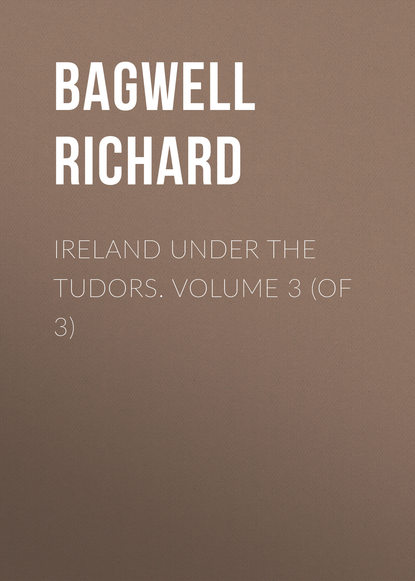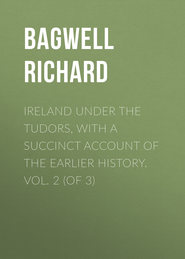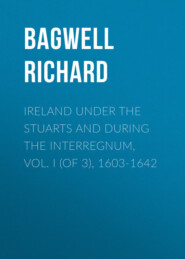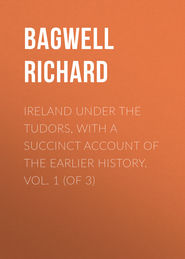По всем вопросам обращайтесь на: info@litportal.ru
(©) 2003-2024.
✖
Ireland under the Tudors. Volume 3 (of 3)
Настройки чтения
Размер шрифта
Высота строк
Поля
408
Four Masters, 1602; O’Donnell to O’Connor Kerry, May 24, in Carew; List of Irish refugees in Pacata Hibernia, book ii. chap. xxii. The extreme claim of the O’Donnells included not only Tyrconnell, but Tyrone, Fermanagh, and all Connaught; see Docwra’s Narration.
409
For James Blake’s designs see Carew to Mountjoy, May 28 and Oct. 9, in Carew and Pacata Hibernia, book iii. chap. xv. The story of John Anias may be read in the Life of Florence MacCarthy, Maclean’s Letters of Cecil to Carew, and in Pacata Hibernia, book iii. chap. vii. For Tyrconnell’s case see Wotton to James I., April 24, 1608, in Russell and Prendergast’s Calendar, and his subsequent letters in the same volume.
410
Lambert to Mountjoy, June 18, 1602; Four Masters.
411
Docwra’s Narration, 1602 till April 20. Docwra to the Privy Council, March 11.
412
Docwra’s Narration, June to September; Tyrone to O’Connor Sligo in Moryson, book iii. chap. ii.; Mountjoy to Lambert, Sept. 12; Lord Dunkellin and Sir A. Savage to Mountjoy, Aug. 7; Mountjoy to Cecil, Oct. 12.
413
Pacata Hibernia, book iii. chaps. xii. and xiv.; Cecil to Carew, Oct. and Nov. 4; Privy Council to Carew, Dec. 16 – all in Carew.
414
O’Sullivan Bere, Hist. Cath. tom. iii. lib. vii. chaps. viii. to xii. The Four Masters describe this wonderful march to Aughrim, and are perhaps preferable as far as they go. See also Pacata Hibernia, book iii. chap. xvii. The itinerary is as follows, as near as I can make it out: – 1. (Jan. 4) Ballyvourney; 2. Pobble O’Keefe (near Millstreet); 3. Ardpatrick (in Limerick); 4. Solloghead (near Limerick Junction); 5 and 6. Ballinakill (in Tipperary); 7. Latteragh (eight miles south of Nenagh); 8. Loughkeen; 9 and 10. Portland; 11. Aughrim (in Galway); 12. Ballinlough (in Roscommon); 13 and 14. Woods near Boyle; 15. Knockvicar; 16. Leitrim. The dates are made clear by Carew’s letter to the Privy Council, Jan. 22, 1603, in Carew.
415
Tyrone to Mountjoy, Dec. 12/22, 1602, and March 19/29, 1603; Moryson, book iii. chap. i.; Pacata Hibernia, book iii. chap. xx.; Carew to the Privy Council, Jan. 22, in Carew, and Cecil’s letter to Carew, passim; O’Connor Sligo to Cecil, March 1, 1603.
416
Docwra’s Narration, December; Bodley’s visit to Lecale in vol. ii. of Ulster Arch. Journal; Capt. Thomas Phillips to Cecil, July 27, 1602; Mayor and Sheriffs of Dublin to Cecil, Jan. 17, 1603; Mountjoy to Cecil, Jan. 8 and 20; Docwra to the Privy Council, Feb. 23.
417
Moryson, part iii. book iii. chaps. i. and v.; O’Sullivan, tom. iii. lib. viii. cap. 6; Four Masters, 1603. In describing his visit to Lecale at the beginning of 1603, Bodley casually remarks that the Irish soldiers ate grass —vescuntur gramine. Moryson says the wild Irish ‘willingly eat the herb shamrock, being of a sharp taste, which as they run and are chased to and fro, they snatch like beasts out of the ditches.’ This passage is conclusive proof that the wood-sorrel was called shamrock in the sixteenth century; see above, note to chap. xxxix. Modern claimants to the title of shamrock are the white clover, the common trefoil (medicago lupulina), and the bog-bean (menyanthes trifoliata); but none of these are edible by men.
418
Queen Elizabeth to King James VI., June or July, 1585, in Bruce’s Letters of those two sovereigns, also Dec. 2, Feb. 3, 1601-2, and ‘after July,’ 1602; James VI. to Tyrone, Aug. 10, 1597, in Lansdowne MSS.; Tyrone to James VI., April 10, 1600, in Scotch Calendar; and the letters printed in Ulster Arch. Journal, vol. v. pp. 205-8.
419
Mountjoy to Cecil, Jan. 20, 1603; to Vice-Treasurer Carey, Jan. 25; Lord Deputy and Council to the Privy Council, Feb. 26 (draft in Carew).
420
Cecil to Mountjoy, Feb. 18, 1603, in Carew; Moryson, book iii. chap. ii.
421
Moryson, book iii. chap. ii.
422
There is a valuable paper on hawks and hounds in Ireland by Mr. J. P. Prendergast in vol. ii. of the Irish Arch. Journal, p. 144. Perrott to Walsingham, Oct. 25, 1585; Sir S. Bagenal to Cecil, MS. Hatfield, Nov. 1, 1602. In the second edition (1888) of Dalziel’s British Dogs there is a very full dissertation on the Irish wolf-hound. In Payne’s Brief Description of Ireland, 1590, we read that a red-deer skinned could be had for 2s. 6d., twelve quails for 3d., twelve woodcocks for 4d., and all other fowl rateably. The abundance of corncrakes is mentioned by both Moryson and Payne, and the latter says grouse (heathcock) were plentiful. Sixteen landrails (or corncrakes) were shot at Colebrooke in Fermanagh on one September day in 1884.
423
Fynes Moryson’s Itinerary, part iii. book iii. chap. v. Sir N. White to Burghley, July 22, 1580. For ploughing by the tail, &c. see Dineley’s Tour, p. 162. The Scotch Highlanders bled their cattle even to the 19th century, see the Duke of Argyle’s Scotland as it was and as it is, vol. ii. p. 123. Cæsar says of the Britons: ‘pecorum magnus numerus… Interiores plerique frumenta non serunt, sed lacte et carne vivunt.’ (B.G. lib. v. cap. 12-14.) Payne says a fat sheep could be had in 1590 for 2s. 6d. and a fat beef for 13s. 4d. ‘Filthy butter,’ says Moryson; ‘hairy butter too loathsome to describe,’ says Andrew Trollope.
424
Several notices are collected in Ulster Journal of Archæology, iii. 186, 187. See Grose’s Antiquarian Repository, iv. 627. The lax-weir at Limerick preserves the Norse name for salmon.
425
Moryson, III. iii. 5; Dymmok’s Treatise of Ireland, about 1600; Petty’s Political Anatomy, 1672; Sir T. Heneage to Carew, Dec. 22, 1590, in Carew. On July 19, 1602, the mayor of Waterford sent Cecil ‘a pair of bed coverings and two rendells of aqua-vitæ.’ – MS. Hatfield.
426
Irish Statutes, 3 and 4 Ph. and Mary, cap. 7; Moryson, III. iii. 5; Dymmok; Bodley’s Descriptio itineris in Lecaliam, ann. 1602; Barnaby Riche’s Treatise delivered to Lord Salisbury 1610. After the journey described further on, Captain Bodley and his friends warmed themselves with sherry ‘with burnt sugar, nutmeg, and ginger.’
427
Dymmok and Moryson, ut sup.; Andrew Trollope to Walsingham (from Dublin), Sept. 12, 1581. Trollope had then been over two months in Ireland. There are some curious details in the Travels of Nicander Nucius, a Corfiote, who visited England in Henry VIII.’s time, printed (Greek text and translation) by the Camden Society.
428
Fenton to Burghley, Aug. 26, 1595; Mayor of Chester’s letter, June 18, 1597; Sir John Dowdall to Burghley, March 9, 1596, and to Cecil, Jan. 2, 1600; Proclamation by Tyrone, Feb. 2, 1601. The Irish text of the latter, with a contemporary translation, is printed from the Lambeth MSS. in Ulster Arch. Journal, vol. vi. p. 60. Mountjoy to Cecil, Aug. 10, 1602, printed by Moryson.
429
Fynes Moryson’s Itinerary, part iii. book iv. chap. ii.; Spenser’s State of Ireland; Derrick’s Image of Ireland, where the description of the more uncivilised natives closely resembles those of Moryson and Spenser. Articles with Tyrone, June 17, 1590, in Carew. A paper dated 1599 by Carew (No. 319) proposes that every soldier should have an Irish mantle, ‘which costeth but 5s., to be his bed in the night and a great comfort to him in sickness and health; for being never so wet, it will with a little shaking and wringing be presently dry.’ Among the properties for a play on the state of Ireland by John Heywood, performed before Edward VI. were ‘three yards of grey kersey for an Irishman’s coat with great and long plyghts, four yards of orange-coloured frisado at 4s. a yard, &c.’ – Kempe’s Loseley MSS.
430
Von Raumer’s Sixteenth Century, letter 60, where De Beaumont, or his translator, writes Clancarty instead of Clanricarde; Manningham’s Diary, Oct. 1602 and April 1603; Chamberlain’s Letters, Oct. 2, 1602; Sir John Davis to Cecil, Dec. 8, 1604.
431
Spenser; Campion; Bodley’s Voyage to Lecale in the 2nd vol. of the Ulster Arch. Journal, and articles by H. F. Hore in the same journal; Morrin’s Patent Rolls, 40 Eliz. No. 54; Derrick’s Image of Ireland; Smith’s Cork, i. 249; and see above vol. ii. p. 65. The ‘carrows’ were not extinct in Charles II.’s time – see Dineley’s Tour, p. 19.
432
Bodley’s Visit to Lecale, 1603; Cecil to Carew. Dec. 15, 1600; Sir John Stanhope to Carew, Jan. 26, 1601: both in Carew.
Four Masters, 1602; O’Donnell to O’Connor Kerry, May 24, in Carew; List of Irish refugees in Pacata Hibernia, book ii. chap. xxii. The extreme claim of the O’Donnells included not only Tyrconnell, but Tyrone, Fermanagh, and all Connaught; see Docwra’s Narration.
409
For James Blake’s designs see Carew to Mountjoy, May 28 and Oct. 9, in Carew and Pacata Hibernia, book iii. chap. xv. The story of John Anias may be read in the Life of Florence MacCarthy, Maclean’s Letters of Cecil to Carew, and in Pacata Hibernia, book iii. chap. vii. For Tyrconnell’s case see Wotton to James I., April 24, 1608, in Russell and Prendergast’s Calendar, and his subsequent letters in the same volume.
410
Lambert to Mountjoy, June 18, 1602; Four Masters.
411
Docwra’s Narration, 1602 till April 20. Docwra to the Privy Council, March 11.
412
Docwra’s Narration, June to September; Tyrone to O’Connor Sligo in Moryson, book iii. chap. ii.; Mountjoy to Lambert, Sept. 12; Lord Dunkellin and Sir A. Savage to Mountjoy, Aug. 7; Mountjoy to Cecil, Oct. 12.
413
Pacata Hibernia, book iii. chaps. xii. and xiv.; Cecil to Carew, Oct. and Nov. 4; Privy Council to Carew, Dec. 16 – all in Carew.
414
O’Sullivan Bere, Hist. Cath. tom. iii. lib. vii. chaps. viii. to xii. The Four Masters describe this wonderful march to Aughrim, and are perhaps preferable as far as they go. See also Pacata Hibernia, book iii. chap. xvii. The itinerary is as follows, as near as I can make it out: – 1. (Jan. 4) Ballyvourney; 2. Pobble O’Keefe (near Millstreet); 3. Ardpatrick (in Limerick); 4. Solloghead (near Limerick Junction); 5 and 6. Ballinakill (in Tipperary); 7. Latteragh (eight miles south of Nenagh); 8. Loughkeen; 9 and 10. Portland; 11. Aughrim (in Galway); 12. Ballinlough (in Roscommon); 13 and 14. Woods near Boyle; 15. Knockvicar; 16. Leitrim. The dates are made clear by Carew’s letter to the Privy Council, Jan. 22, 1603, in Carew.
415
Tyrone to Mountjoy, Dec. 12/22, 1602, and March 19/29, 1603; Moryson, book iii. chap. i.; Pacata Hibernia, book iii. chap. xx.; Carew to the Privy Council, Jan. 22, in Carew, and Cecil’s letter to Carew, passim; O’Connor Sligo to Cecil, March 1, 1603.
416
Docwra’s Narration, December; Bodley’s visit to Lecale in vol. ii. of Ulster Arch. Journal; Capt. Thomas Phillips to Cecil, July 27, 1602; Mayor and Sheriffs of Dublin to Cecil, Jan. 17, 1603; Mountjoy to Cecil, Jan. 8 and 20; Docwra to the Privy Council, Feb. 23.
417
Moryson, part iii. book iii. chaps. i. and v.; O’Sullivan, tom. iii. lib. viii. cap. 6; Four Masters, 1603. In describing his visit to Lecale at the beginning of 1603, Bodley casually remarks that the Irish soldiers ate grass —vescuntur gramine. Moryson says the wild Irish ‘willingly eat the herb shamrock, being of a sharp taste, which as they run and are chased to and fro, they snatch like beasts out of the ditches.’ This passage is conclusive proof that the wood-sorrel was called shamrock in the sixteenth century; see above, note to chap. xxxix. Modern claimants to the title of shamrock are the white clover, the common trefoil (medicago lupulina), and the bog-bean (menyanthes trifoliata); but none of these are edible by men.
418
Queen Elizabeth to King James VI., June or July, 1585, in Bruce’s Letters of those two sovereigns, also Dec. 2, Feb. 3, 1601-2, and ‘after July,’ 1602; James VI. to Tyrone, Aug. 10, 1597, in Lansdowne MSS.; Tyrone to James VI., April 10, 1600, in Scotch Calendar; and the letters printed in Ulster Arch. Journal, vol. v. pp. 205-8.
419
Mountjoy to Cecil, Jan. 20, 1603; to Vice-Treasurer Carey, Jan. 25; Lord Deputy and Council to the Privy Council, Feb. 26 (draft in Carew).
420
Cecil to Mountjoy, Feb. 18, 1603, in Carew; Moryson, book iii. chap. ii.
421
Moryson, book iii. chap. ii.
422
There is a valuable paper on hawks and hounds in Ireland by Mr. J. P. Prendergast in vol. ii. of the Irish Arch. Journal, p. 144. Perrott to Walsingham, Oct. 25, 1585; Sir S. Bagenal to Cecil, MS. Hatfield, Nov. 1, 1602. In the second edition (1888) of Dalziel’s British Dogs there is a very full dissertation on the Irish wolf-hound. In Payne’s Brief Description of Ireland, 1590, we read that a red-deer skinned could be had for 2s. 6d., twelve quails for 3d., twelve woodcocks for 4d., and all other fowl rateably. The abundance of corncrakes is mentioned by both Moryson and Payne, and the latter says grouse (heathcock) were plentiful. Sixteen landrails (or corncrakes) were shot at Colebrooke in Fermanagh on one September day in 1884.
423
Fynes Moryson’s Itinerary, part iii. book iii. chap. v. Sir N. White to Burghley, July 22, 1580. For ploughing by the tail, &c. see Dineley’s Tour, p. 162. The Scotch Highlanders bled their cattle even to the 19th century, see the Duke of Argyle’s Scotland as it was and as it is, vol. ii. p. 123. Cæsar says of the Britons: ‘pecorum magnus numerus… Interiores plerique frumenta non serunt, sed lacte et carne vivunt.’ (B.G. lib. v. cap. 12-14.) Payne says a fat sheep could be had in 1590 for 2s. 6d. and a fat beef for 13s. 4d. ‘Filthy butter,’ says Moryson; ‘hairy butter too loathsome to describe,’ says Andrew Trollope.
424
Several notices are collected in Ulster Journal of Archæology, iii. 186, 187. See Grose’s Antiquarian Repository, iv. 627. The lax-weir at Limerick preserves the Norse name for salmon.
425
Moryson, III. iii. 5; Dymmok’s Treatise of Ireland, about 1600; Petty’s Political Anatomy, 1672; Sir T. Heneage to Carew, Dec. 22, 1590, in Carew. On July 19, 1602, the mayor of Waterford sent Cecil ‘a pair of bed coverings and two rendells of aqua-vitæ.’ – MS. Hatfield.
426
Irish Statutes, 3 and 4 Ph. and Mary, cap. 7; Moryson, III. iii. 5; Dymmok; Bodley’s Descriptio itineris in Lecaliam, ann. 1602; Barnaby Riche’s Treatise delivered to Lord Salisbury 1610. After the journey described further on, Captain Bodley and his friends warmed themselves with sherry ‘with burnt sugar, nutmeg, and ginger.’
427
Dymmok and Moryson, ut sup.; Andrew Trollope to Walsingham (from Dublin), Sept. 12, 1581. Trollope had then been over two months in Ireland. There are some curious details in the Travels of Nicander Nucius, a Corfiote, who visited England in Henry VIII.’s time, printed (Greek text and translation) by the Camden Society.
428
Fenton to Burghley, Aug. 26, 1595; Mayor of Chester’s letter, June 18, 1597; Sir John Dowdall to Burghley, March 9, 1596, and to Cecil, Jan. 2, 1600; Proclamation by Tyrone, Feb. 2, 1601. The Irish text of the latter, with a contemporary translation, is printed from the Lambeth MSS. in Ulster Arch. Journal, vol. vi. p. 60. Mountjoy to Cecil, Aug. 10, 1602, printed by Moryson.
429
Fynes Moryson’s Itinerary, part iii. book iv. chap. ii.; Spenser’s State of Ireland; Derrick’s Image of Ireland, where the description of the more uncivilised natives closely resembles those of Moryson and Spenser. Articles with Tyrone, June 17, 1590, in Carew. A paper dated 1599 by Carew (No. 319) proposes that every soldier should have an Irish mantle, ‘which costeth but 5s., to be his bed in the night and a great comfort to him in sickness and health; for being never so wet, it will with a little shaking and wringing be presently dry.’ Among the properties for a play on the state of Ireland by John Heywood, performed before Edward VI. were ‘three yards of grey kersey for an Irishman’s coat with great and long plyghts, four yards of orange-coloured frisado at 4s. a yard, &c.’ – Kempe’s Loseley MSS.
430
Von Raumer’s Sixteenth Century, letter 60, where De Beaumont, or his translator, writes Clancarty instead of Clanricarde; Manningham’s Diary, Oct. 1602 and April 1603; Chamberlain’s Letters, Oct. 2, 1602; Sir John Davis to Cecil, Dec. 8, 1604.
431
Spenser; Campion; Bodley’s Voyage to Lecale in the 2nd vol. of the Ulster Arch. Journal, and articles by H. F. Hore in the same journal; Morrin’s Patent Rolls, 40 Eliz. No. 54; Derrick’s Image of Ireland; Smith’s Cork, i. 249; and see above vol. ii. p. 65. The ‘carrows’ were not extinct in Charles II.’s time – see Dineley’s Tour, p. 19.
432
Bodley’s Visit to Lecale, 1603; Cecil to Carew. Dec. 15, 1600; Sir John Stanhope to Carew, Jan. 26, 1601: both in Carew.








